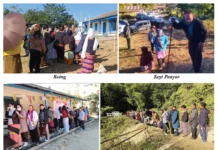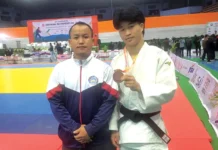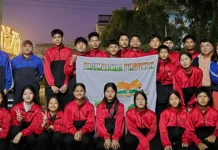[ Likha Tatam ]
Let us retrospect how, when and why Nyokum was organi-sed in Joram village before and after it came to be a mass agricultural and cultural festival of the Nyishi community in the year 1967.
We are told that Nyokum was organised in the villages of Joram in Lower Subansiri (now KeyiPanyor) district since time immemorial for our good health and bumper agriculture crops, mainly wet rice cultivation, which was and is till now a staple food of the Nyishi community, particularly of Joram area. Nyokum was usually organised as Nyokum Uii Panam, which the people of Joram villages called Nyokum Nyoin Henam. The word ‘Nyokum’ consists of ‘Nyok’ and ‘Kum’. Nyok means ‘land’ and Kum means ‘gather together’. Initially, Joram village consisted of a cluster of villages such as Pekir (Phu), Peil, Migo and Sekh. For the purpose of Nyokum Uii these villages were divided into two groups, that was Pekir (Phu) and Peil as one group, and Migo and Sekh as the other group. Nyokum was organised on rotation basis among these groups in every succeeding year, usually in the last part of June or in the first part of the July, after a few days of completion of paddy seedling transplantation in WRC fields and at the beginning of their germination. Nyokum Uii Panam was usually organised through chicken liver examination to determine the mode and host of celebration. After chicken liver examination, the Nyokum Uii Panamwas conducted at a selected house as the host. Nyup, the priest, with bu, the priest’s assistant, chanted Nyokum Nyoin hymns lyrically to appease the benevolent uii (spirit) by offering a number of chickens and animals with the hope of being blessed in return with good health and proper growth of paddy seeds, so that people could live in peace and prosperity for one agricultural season. The nyub and the bu, along with the members of the host house and a selected group of people did the diir sonbo dance along the way and visited each and every house of the village in order to drive away the diir uii and women swept behind them and threw away all the unused things from their houses in the belief that these things were the poor spirit which led the family of that house to live the life of poverty.
The people of each and every house followed behindthe nyub, bu and diir sonbo with male memberscarrying khomey in their hand and female memberscarrying iggin in their backpacked with food (rice) and drinks (oppo). The crowd gradually increasedfrom every visited household and became a huge procession when they reached the altar, called Nyokum Nyugu, which is usually installed at a high place of the village at the venue called Nyokum Putu on the second day. On the third day, early in the morning, all the male members of various age groupsof the host village gathered at Nyokum Putu and proceeded for Dapo Poyenum in order to instal prohibition posts at a few selected junction points to restrict the entry of strangers or outsiders into the village and exit from the village for a few days till Tvjwr Panam day. After Dapo Ponam works, the Dapo members went to the villages of other group where food (rice), drinks (oppo) and meat (vdwn) were lavishly served, called ajwn honam. Each family had their own chosen friend for the day called Nyokum ajwn, who had to generally reciprocate the next year with the exact or more hospitality in return.Fourth, fifth & sixth day were rest days or prohibited days as no outsider was allowed to enter and no villager was allowed to exit or do any kind of physical work outside the house or any work that produced loud sound which could disturb the nature. On the sixth evening, the nyub (priest) came to the host’s house and chanted Tvjwr Pahnam and in next day or the seventh day the nyub came to the venue,Nyokum Putu, along with a bunch of Tvjwr and Oot of water. Nyub placed the required Tvjwr on the Nyokum Nyugu and poured tvjwr wss (tvjwr water) and then distributed the rest of the tvjwr and water to needy wet rice cultivation (WRC) owner. The WRC owner received the tvjwr and iss and went to their respective WRC field and placed tvjwr as well as poured tvjwr water at the northern end or at the main irrigation source of that field, so that any unwanted things that destroyed the paddy could be removed and damaged crops could be healed. That way the Nyokum Ui Panam activities ended for the year and the people expected a bumper harvest.
We are also told time and again that during the Dapo prohibition, many outsiders were detained or attacked physically and were imposed huge pecuniary punishments by the villagers as and when one enteredinto the prohibited area on the prohibition day eveninnocently or unknowingly. These incidences made other people and the government curious about Nyokum Uii Panam, which finally made the government compelled to recognise the Nyokum Panam, which led to the organised first modern or central Nyokum in 1967 in Joram village and adoption of Nyokum as the festival of the Nyishi community and there onward, Nyokum became the common festival which spread to other parts of the Nyishi inhabited areas. The few intellectuals of the community started pondering on the significance of Nyokum festival and interpreted the meaning and mode of Nyokum celebration based on the presumably assumed mythology told by our forefathers and adopted in consensus.
Let us also see why the Nyokum Uii Panam was organised in those days in the village. During these days there was no proper access of modern amenities like road, school, medical, agricultural and allied activities. People were solely dependent on agriculture and allied produce for their daily living. The people practiced indigenous way of cultivation,because of which most of the time people lived in starvation due to insufficient produces from unscientific cultivation. During that period, the people were totally illiterate and innocent and they were completely dependent on nature andworshipped natural objects and offered sacrifice birds and animals in order to appease the natural spirits, so that nature would be pleased and bless them abundantly in return for healthy and wealthy living.
And let us also discuss how contemporary Nyokum is celebrated. Obviously, with the advent of education and modern improved new technology in the villages, people are no longer dependent on the natural spirit for a bumper harvest but rather use new farming technology and high yielding variety of seeds thatproduce agricultural produces more than required,and similarly depend on medical facilities for healthy living.
Nowadays Nyokum is organised nominally just to showcase the traditional costumes of the community and to keep the identity alive for the future generation from the the 24th to the 26th day of February every year, which might have shifted the Nyokum celebration to pre-cultivation season. In this way, many people organise symbolic Nyokum in the form of advance Nyokum or pre-Nyokum in many cities of the country as well as in universities, colleges, offices, individual households, etc, by offer traditionally produced gifts, food and drinks to the guests, where the mythology or the genesis of the Nyokum is read out. The participants of the community usually wear traditional attire of various forms and designs during the Nyokum celebration.This form of celebration has no involvement of nyub (priest), no birds or animals sacrifices, no installation of altars (nyugu), no lyrical chanting or prayer. It involves only merrymaking, greeting, dance drama performance, games and sports activities, Nyokum history-telling in chronology and community feasting. However, formal imitation of past are done sometimes, and most of the modern Nyokum in the villages are also organised without any act of ritual; instead games & sports activities and cultural shows are organised, guests from outside are invited, and there is no prohibition as practiced in the original form of Nyokum. Following the increase in the number of intellectuals in the community, many are striving to go back to the original form of Nyokum to keep the olden identity alive, and also endeavouringto interpret the meaning of Nyokum in a more refined way and trying to claim absolute guardianship of Nyokum. As a result, many have made it a means of living. Today, the differences of opinions among the faith group developed on the mode of celebration of Nyokum and trying to take it to the line of religion by suffixing a new word, ‘Yullo’, which was not in original form of Nyokum or in the initial years of celebration of modern Nyokum with a notion to preserve the community identity alive.
For me the word Nyokum actually should be Nyiokum, which is derived from two words Nyi+Okum, that is Nyi for ‘people’ and Okum for ‘come together’, which means people coming together in a particular place to celebrate Nyokum in a traditional attire with dance drama performance and community feast.
Last but not least, I opine that academicians, intellectuals, and CBOs, religious leaders of various faith groups of the community, such as the Nyishi Festival Committee, the Central Nyokum Committee,the Nyishi Indigenous Identity Society, the Nyishi Indigenous Faith and Cultural Society, the Nyishi Art & Culture Society, the Nyishi Baptist Church Council, etc, should sit together to draw a agreeable common Nyokum festival code in the best interest of the community in order to keep alive the cultural identity and to maintain the cordial atmosphere among the community members, keeping in mind that no more appeasement lyrical chanting, animal sacrifices, etc, are required for a bumper harvest of crops, especially with the advent of the education and know-how of farming.
The above narration is based on my personal experiences and opinion as a native of Joram village where Nyokum originated, and also based on my regular observations and participation in Nyokumcelebration in different areas since 1980 till date, as well as from the information or opinion expressed by various people through social media and hence, expressions and opinions are of my own, and have nothing to do with any other. Error, omission, or exaggeration, if any, is regretted. (The views expressed are personal.)



